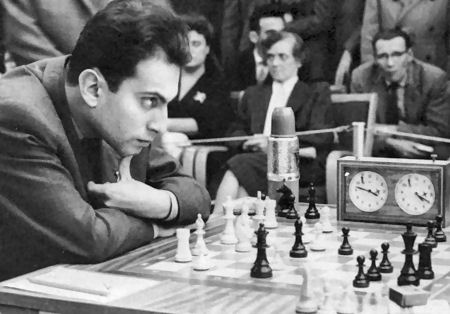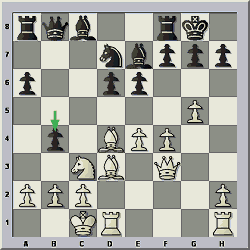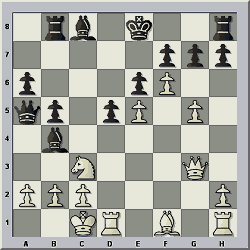
Har nogle ØBRO´er set eller hørt fra vores udsendte medarbejder Niels Lauritsen Aka onkel Lau (fra Uganda) også kendt for bl.a. hans utallige analyser, artikler, 4 gevinster på 8 minutter og hans internationale artikel på chessbase, som også kan læses her. Det ser dog ud til at han ikke længere står på vores styrkeliste?
The true secret of intuition in chess
12.11.2005 – Everybody knows and admires the creative, speculative brilliance of the two great Latvian geniuses Mikhail Tal and Alexei Shirov. Is this a faculty we can all learn and acquire? Driven by need Niels Lauritsen tried to fathom the secret of intuition in chess and came up with a remarkable discovery: it is all about the way knights move.
The real secrets of intuition in chess
Niels Lauritsen
When I turned 50 years, my stamina to play competitive chess started to go downhill. At one point in the chess club after a team match I rather loudly lamented that I could not play for five straight hours at full force anymore. After 3-4 hours of play, I would want a nap. Or drink enough coffee to keep me awake for a week. Or just go zombie and stare clueless at the same position for 20 minutes or more.
Jacob Aagaard, a club mate at the time, then suggested that I should sharpen my game. Force a culmination, a decision, early in the game, to avoid long games. That could be the remedy for me. It sounded attractive at the time. So I pondered it seriously. Hmmm, playing the Albins Countergambit instead of my boring Slavs and Caro-Kanns!? Why not!
But one does not just change styles like that. Trying to change style is not an easy matter. Trying to sharpen the game requires time, too! I would often use a ridiculous amount of time in doing so, ending up in time pressure and fatigue anyway.
In fact, Aagaard could just as well have suggested that I should stop smoking. Or take up regular gym and lose 15 kilos. Both would have had a clearly positive effect on my chess. Fitness and improved rating sound like a good combination. Was it not Botwinnik the iron man who regularly took long walks over the steppes before an important game!
Alas, that fitness trip never quite materialized, either. And who wants to give up smoking just to improve one’s chess game, I ask? So I have continued to be on the lookout for some other means, some magic formula to improve my chess and stamina.
And then one day I found it! The chess bookstore had a book named “Intuition in chess”. With joy in my heart I could read on the back cover that “Players who try to calculate everything to a finish will often lose themselves in a maze of variations, while those who use intuition to the full will save both time and energy…”.
The right remedy indeed. Lucky me! I bought the book and began a serious study of this intuition phenomenon.
It turned out that intuition was especially recommended by players like Smyslov. And that mostly in his later years. So where Kortchnoi will calculate variations concretely, Smyslov would put on the auto pilot.
On the other hand, the real master of intuition turned out to be Michael Tal. Sharp, dubious sacrifices were his brand, often played without calculating concrete variations, but instead played by instinct. Yes, by intuition! And he did it with great success. To defend against Tal is no easy matter.
So I trotted through the book. It has many interesting examples, and many original combinations. Lots of food for thought on middle game positions and how to sharpen the struggle, often through risky play.
But was it intuition, or what? I started to have my doubts.
One example in the book which comes to mind is the famous (infamous!) game by Bent Larsen, a black Nimzo Indian against Taimanov. Larsen played the entirely surprising and greatly weakening move …g7-g5 from nowhere. Risky and unbalancing play in order to confuse the opponent. As the game went, Larsen succeeded.
But stop a while – this is NOT intuition. Larsen realizes that he will go downhill and be left with an inferior position if the game continues along normal lines. So he deliberately unbalances the position and takes his chances in a wild melee.
Taimanov,Mark E – Larsen,Bent [D37]
Vinkovci (13), 20.10.1970
1.d4 Nf6 2.c4 e6 3.Nc3 Bb4 4.Qc2 c5 5.dxc5 0-0 6.Bf4 Bxc5 7.Nf3 Nc6 8.e3 d5 9.a3 Qa5 10.Rc1 Be7 11.Be2 dxc4 12.Bxc4 Nd5 13.Bxd5 exd5 14.Qb3
14…g5!??! 15.Bg3 g4 16.Nd4(?) Nxd4 17.exd4 Bg5 18.0-0 Bxc1 19.Rxc1 Be6 20.h3 gxh3 21.Be5 f6 22.Ne4!? fxe5 23.Qg3+ Bg4! 24.Qxg4+ Kh8 25.Ng5 Qd2 26.Rc7 Qxf2+ 27.Kh2 Qxg2+ and Black won. 0-1.
White should have played 16.Ne5, and after a continuation like 16…d4 17.Nxc6 bxc6 18.exd4 he could have enjoyed the weakness in the black position.
By then I realize that the title of this book is misleading. That intuition is not a phenomenon or a chess element which one can directly isolate and apply. It is more complicated than that.
That does not mean that the book itself is bad. It is more a sort of publishing oversell. As in a “Play with intuition and win” sort of advertisement.
Which always turns out to be an empty promise. Like most opening books. Or a new slimming recipe. They promise a lot, but improvement does not appear, instead grim ordinary life just goes on.
So the term “intuition” was not the magical remedy or concept to solve my stamina problem. It is not an element or technique which can be used as such. Maybe it is just like a term like overprotection, which is one of the elements of Nimzowitsch’s System (which is not a system, by the way).
Nimzowitsch had his bag of tricks, and overprotection was one such. But that does not mean that he methodically sought to overprotect in his games. Or that he always pushed his pawn to e5 against the French Defense.
We might as well replace the term intuition with everyday expressions like “feeling”, or “experience”.
Or, as Anand is expressing it: “Intuition is the first move I see in the position”.
Exactly. It has something to do with spontanious reflexes. Or, in other words, the way we play when we play blitz games (especially 1 minute games). But is that what is ultimately the essence of intuition? Are we talking blitz games here?
I think that the truth is that there is no shortcut to improving ones chess. It is, as we have known all along, a question of hard work and a devoted attitude.
But then what about the natural ease by which Tal won his sharp and intuitive games? What was his secret? At this stage I am reminded by the painful memory of the tenth and final game in the semifinal match between Tal and Larsen in 1965. Painful, because Tal won that game, and the match 5.5 points to 4.5 points, while I had been cheering for Larsen, my tribesman and hero.
Tal,Mihail – Larsen,Bent [B82]
Candidates sf1 Bled (10), 1965
1.e4 c5 2.Nf3 Nc6 3.d4 cxd4 4.Nxd4 e6 5.Nc3 d6 6.Be3 Nf6 7.f4 Be7 8.Qf3 0-0 9.0-0-0 Qc7 10.Ndb5 Qb8 11.g4 a6 12.Nd4 Nxd4 13.Bxd4 b5 14.g5 Nd7 15.Bd3 b4
Tal has just played Bf1-d3, to which Larsen replied b5-b4. The game continued with 16.Nd5!?, a chancy and risky piece sacrifice. The game went on and Tal won in his usual murky and street fighting manner.
16.Nd5 exd5 17.exd5 f5 18.Rde1 Rf7 19.h4 Bb7 20.Bxf5 Rxf5 21.Rxe7 Ne5 22.Qe4 Qf8 23.fxe5 Rf4 24.Qe3 Rf3 25.Qe2 Qxe7 26.Qxf3 dxe5 27.Re1 Rd8 28.Rxe5 Qd6 29.Qf4 Rf8 30.Qe4 b3 31.axb3 Rf1+ 32.Kd2 Qb4+ 33.c3 Qd6 34.Bc5 Qxc5 35.Re8+ Rf8 36.Qe6+ Kh8 37.Qf7 and black resigned. 1-0.
Note that Tal’s sacrifice is not intuition. It was prepared already by the move before, 13.Bd3. Likewise, Larsen could not have been surprised by the sacrifice. His …b5-b4 almost forces it. Invites it!
I quote from Pachman: ”There has been much analysis of this critical position. Tal’s combination cannot be analyzed to the end through concrete variations, but is more played by intuition. It is rare to se a grandmaster choose such an adventure, such a risky approach, in such an important and decisive game. But in this match we have two players who both have in common that they are daring optimists by nature. They both possess what in sports can be termed as natural cheek.”
No wonder why I (intuitively) recalls this game, because Pachman uses the very term himself! But this nevertheless does not overturn the arguments I have already tabled.

Playing with his knights: Latvian chess genius Mikhail Tal
And the explanation for Tal’s apparent buccaneering playing style, and his unclear sacrifice in theEntscheidungspartie against Larsen, is to be found a completely different place.
Tal is born and grew up in the town of Riga, the capital of Latvia. Here, the chess rules have always been a bit different from the rest of the continent. One main difference is that the knights, just like the pawns, can only go forwards, not go back. Throughout his upbringing, Tal has been playing with this rule. And it has been so embedded in his subconscious, that he often forgot that in play and tournaments outside of his native resort, knights were also allowed to move backwards.
Occasionally, this even influenced his play in world championship matches. And that is real and obvious explanation for Tal’s dubious and risky sacrifices, including his move 16.Nd5 against Larsen. The knight has to move, and can only move forward!
Tal, a world champion at one point, understandably was embarrassed by these occasional slips, and he never admitted his handicap to any outsider. Since his moves often won anyway, the secret was kept until now.
But I can hereby disclose the truth. It has been told to me by Alexei Shirov, with whom I shared a keg of wine in Seville lately. Late in the night he narrated how he used to play and analyze with Tal and enjoy and admire the wild and risky playing style.
Alexei Shirov, one of the great intuitive attackers of our time
As we all know, Shirov is also from Latvia, and was also brought up with the rule about the knights only moving forward. So Tal and Shirov would often play and analyze with their “intuitive” rules for the knights. Many of their opening preparations were also based upon this flawed childhood rule.
It has influenced Shirov’s own playing style just as much as for Tal. Just look at these examples:
Kortschnoj,Viktor (2645) – Shirov,Alexei (2690) [A21]
Madrid Madrid (7), 1996
1.c4 e5 2.g3 f5 3.Bg2 Nf6 4.d3 Bb4+ 5.Nc3 Bxc3+ 6.bxc3 d6 7.Nf3 c5 8.0-0 Nc6 9.Ne1 0-0 10.Nc2 Be6 11.Ne3 Qd7 12.Nd5 Ne7 13.Qb3 Nexd5 14.cxd5 Bf7 15.c4 Bh5 16.f3 Rae8 17.e4 f4 18.gxf4 exf4 19.d4 cxd4 20.Bb2
Black has put all his men in good positions. The comments from the press room at the time indicated that Shirov could now play 20…Qc7 21.Bxd4 Nd7 and put the knight on the square e5, with dominant effect.
It is only now that we realize that such a maneuver would never be allowed to surface in Shirov’s natural subconscious intuition of knights-can-only-move-forward-never-backward.
So Shirov instead played 20…Nxe4 and went on to win after 21.fxe4 Qg4 22.h3 Qg5 23.Kh1 Qh4 24.Kg1 Rf6 25.Bxd4 Rg6 26.Kh1 Rxg2 27.Kxg2 Rxe4 28.Bg1 Re2+ 29.Kh1 Bg6 30.Bf2 Be4+ and White resigned. 0-1.
Here’s another position:
Shirov,Alexei (2685) – Polgar,Judit (2665) [B54]
Yerevan ol (Men) Yerevan (13), 1996
1.e4 c5 2.Nf3 e6 3.d4 cxd4 4.Nxd4 Nc6 5.Nc3 d6 6.g4 Nge7 7.Be3 Ng6 8.Nb3 a6 9.Qd2 b5 10.0-0-0 Nge5 11.g5 Na5 12.f4 Nec4 13.Qf2 Rb8 14.f5 Nxe3 15.Qxe3 Qb6 16.Qg3 Be7 17.Nxa5 Qxa5 18.e5 d5 19.f6 Bb4
Black has just played …Bb4 with the intent to take on c3 and inflict a serious injury to the white pawn structure. So the knight must move. And in Shirov’s universe the knight would be limited to only two candidate moves. So he (naturally!) played
20.Nxd5?! exd5 21.e6 Rb7! Shirov may only have anticipated 21…Qxa2 22.exf7+ Kd8 23.c3 gxf6 24.Qxb8 Qa1+ 25.Kc2 Qa4+ 26.Kd2 winning. 22.exf7+ Kxf7 23.fxg7 Re8 24.g6+ Kxg7 25.gxh7+ Kh8 26.Rg1 and with 26…Qd8 black could have kept the upper hand. An example to show that the “Riga variation” not always come out on top. The game ended 26…Rxh7 27.Qg6 Qd8 28.Bd3 Qe7 29.Qxh7+ Qxh7 30.Bxh7 Kxh7 31.Rxd5 Bf8 32.Rdd1 Re2 33.Rde1 Rxh2 34.Rh1 Rxh1 35.Rxh1+ Kg6 36.Rh8 Kg7 37.Rh1 Kf7 38.Kd2 Ke7 39.Rh7+ Ke6 40.Rc7 Bd7 ½-½.
Now you know the truth behind the “intuitive” sacrifices of Tal and Shirov.
 |
Niels Lauritsen, 60, is a Dane who currently works for the Red Cross in Uganda. During an earlier posting there he won the national chess championship 1993-1995 three years running. He also writes a weekly chess column in the New Vision newspaper. He is a senior international master in correspondence chess. When not somewhere in Africa, he plays in the OBRO chess club in Copenhagen. |





